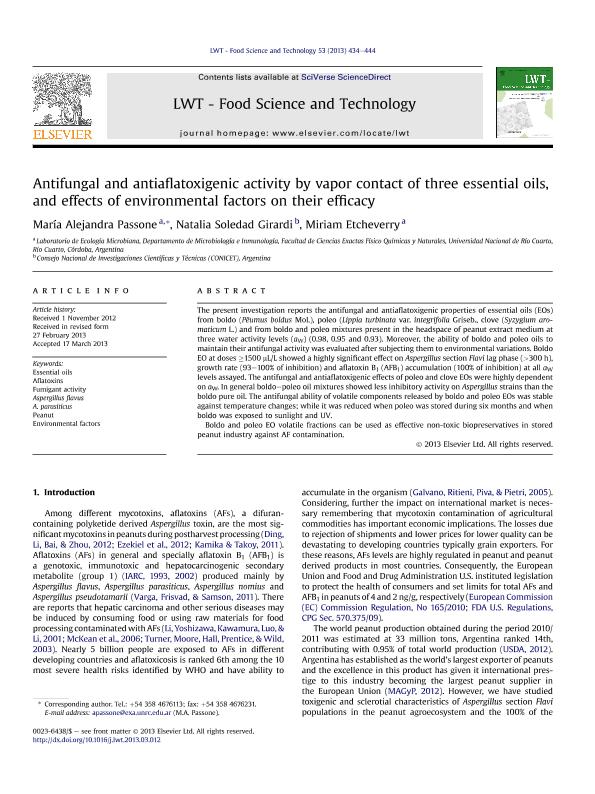Artículo
Antifungal and antiaflatoxigenic activity by vapor contact of three essential oils, and effects of environmental factors on their efficacy
Fecha de publicación:
03/2013
Editorial:
Elsevier Science
Revista:
LWT - Food Science and Technology
ISSN:
0023-6438
Idioma:
Inglés
Tipo de recurso:
Artículo publicado
Clasificación temática:
Resumen
The present investigation reports the antifungal and antiaflatoxigenic properties of essential oils (EOs) from boldo (Pëumus boldus Mol.), poleo (Lippia turbinata var. integrifolia Griseb., clove (Syzygium aromaticum L.) and from boldo and poleo mixtures present in the headspace of peanut extract medium at three water activity levels (aW) (0.98, 0.95 and 0.93). Moreover, the ability of boldo and poleo oils to maintain their antifungal activity was evaluated after subjecting them to environmental variations. Boldo EO at doses ≥1500 μL/L showed a highly significant effect on Aspergillus section Flavi lag phase (>300 h), growth rate (93–100% of inhibition) and aflatoxin B1 (AFB1) accumulation (100% of inhibition) at all aW levels assayed. The antifungal and antiaflatoxigenic effects of poleo and clove EOs were highly dependent on aW. In general boldo–poleo oil mixtures showed less inhibitory activity on Aspergillus strains than the boldo pure oil. The antifungal ability of volatile components released by boldo and poleo EOs was stable against temperature changes; while it was reduced when poleo was stored during six months and when boldo was exposed to sunlight and UV. Boldo and poleo EO volatile fractions can be used as effective non-toxic biopreservatives in stored peanut industry against AF contamination.
Archivos asociados
Licencia
Identificadores
Colecciones
Articulos(CCT - CORDOBA)
Articulos de CTRO.CIENTIFICO TECNOL.CONICET - CORDOBA
Articulos de CTRO.CIENTIFICO TECNOL.CONICET - CORDOBA
Citación
Passone, Maria Alejandra; Girardi, Natalia Soledad; Etcheverry, Miriam Graciela; Antifungal and antiaflatoxigenic activity by vapor contact of three essential oils, and effects of environmental factors on their efficacy; Elsevier Science; LWT - Food Science and Technology; 53; 2; 3-2013; 434-444
Compartir
Altmétricas




